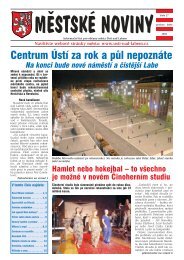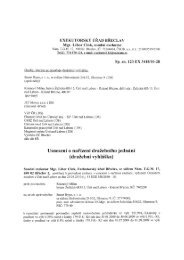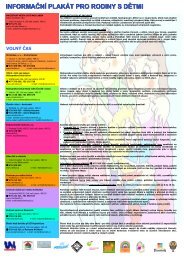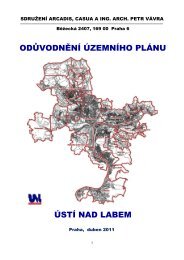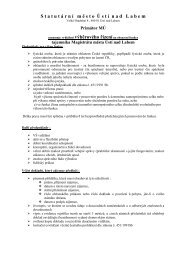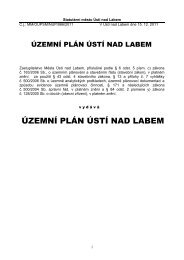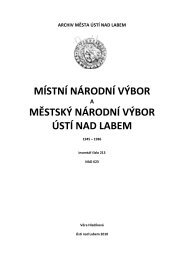Historie a památky města Ústí nad Labem History and monuments of ...
Historie a památky města Ústí nad Labem History and monuments of ...
Historie a památky města Ústí nad Labem History and monuments of ...
Erfolgreiche ePaper selbst erstellen
Machen Sie aus Ihren PDF Publikationen ein blätterbares Flipbook mit unserer einzigartigen Google optimierten e-Paper Software.
92<br />
CZ ENG DE<br />
SEVEROČESKÉ DIVADLO OPERY A BALETU<br />
S hospodářským rozvojem <strong>města</strong> <strong>Ústí</strong> <strong>nad</strong> <strong>Labem</strong> ve druhé<br />
polovině 19. století šel ruku v ruce také rozvoj na poli umění a<br />
kultury. S budováním divadla v <strong>Ústí</strong> <strong>nad</strong> <strong>Labem</strong> se začalo roku<br />
1899. V roce 1903 byl založen Spolek pro výstavbu divadla. Ze<br />
42 nabídek byl roku 1907 vybrán návrh architekta Alex<strong>and</strong>era<br />
Grafa; stavební práce<br />
provedla firma Alwin<br />
Kőhler & Co., která<br />
výstavbu zahájila na<br />
jaře 1908. Budova byla<br />
určena pro 878 diváků a<br />
při slavnostním otevření<br />
21. září 1909 byla uvedena<br />
Gillparzerova hra<br />
Sappho, ve které hlavní<br />
roli ztvárnila Marie<br />
Pospischilová, první<br />
ředitelka divadla.<br />
Budova Severočeského<br />
divadla opery a baletu je<br />
postavena v doznívajícím<br />
novobarokním<br />
slohu s výrazným uplatněním<br />
secesních prvků;<br />
pokrokovým technickým<br />
řešením byla ve své<br />
době železobetonová<br />
konstrukce stropu. Interiér<br />
divadla je řešen<br />
podle klasického schématu,<br />
v přední části jsou<br />
prostory pro návštěvníky,<br />
v jednotlivých podlažích<br />
různě ztvárněná<br />
foyery a šatny. Hlediště<br />
divadla je velkoryse<br />
pojatý prostor vyzdobený<br />
zlaceným štukem.<br />
Stropu hlediště dominuje<br />
nástěnná alegorická malba Ed.Veita. Kovová opona od Petra<br />
Menše, s názvem Commédia dell´ arte, pochází z přelomu 80.<br />
a 90. let 20. století. Ve stejné době také proběhla poslední rozsáhlá<br />
modernizace technického zázemí divadla.<br />
NORTH BOHEMIAN THEATRE OF OPERA AND BALLET<br />
The economic growth <strong>of</strong> the city <strong>of</strong> <strong>Ústí</strong> <strong>nad</strong> <strong>Labem</strong> in the late<br />
19th century was accompanied by the development <strong>of</strong> arts<br />
<strong>and</strong> culture. The development <strong>of</strong> the city theatre began in<br />
1899. In 1903, the Association for the Theatre Construction<br />
was founded. Of 42 bids a design by architect Alex<strong>and</strong>er Graf<br />
won in 1907. Construction<br />
works were allocated<br />
to Alwin Köhler & Co.,<br />
which commenced the<br />
work in the spring 1908.<br />
The building was designed<br />
for 878 spectators<br />
<strong>and</strong> the inauguration<br />
took place on 21 September<br />
1909 with Gillparzer´s<br />
play Sappho<br />
being performed <strong>and</strong><br />
Marie Pospischilová, the<br />
first director <strong>of</strong> the theatre,<br />
featuring in the main<br />
role.<br />
The North Bohemian<br />
Theatre <strong>of</strong> Opera <strong>and</strong><br />
Ballet is built in the<br />
fading New-Baroque<br />
style with impressive<br />
elements <strong>of</strong> the Secession.<br />
An innovative technical<br />
solution <strong>of</strong> that time<br />
was the reinforced concrete<br />
ceiling. The theatre<br />
interior is designed in<br />
the traditional layout,<br />
the front part features<br />
spaces for visitors, the<br />
floors feature foyers<br />
designed in different sty-<br />
78<br />
les <strong>and</strong> cloakrooms. The<br />
auditorium is a generously<br />
designed area decorated with gold-plated stuccos. The<br />
auditorium ceiling is dominated by a wall allegory painting by<br />
Ed. Veit. The metal curtains by Petr Menš, called Commédia<br />
dell´ arte, date back to the turn <strong>of</strong> the 1980´s <strong>and</strong> 90´s. At the<br />
same time, the last extensive modernization <strong>of</strong> the theatre’s<br />
technical background took place.<br />
NORDBÖHMISCHES OPERN- UND BALLETTTHEATER<br />
Mit der wirtschaftlichen Entwicklung der Stadt <strong>Ústí</strong> <strong>nad</strong> <strong>Labem</strong><br />
in der zweiten Hälfte des 19. Jahrhunderts ging H<strong>and</strong> in H<strong>and</strong><br />
auch die Entwicklung im Bereich Kunst und Kultur. Der Aufbau<br />
des Theaters in <strong>Ústí</strong> <strong>nad</strong> <strong>Labem</strong> wurde im Jahre 1899 begonnen.<br />
Im Jahre 1903 wurde der Verein zum Aufbau des Theaters<br />
gegründet. Von 42 Angebote wurde im Jahre 1907 der<br />
Vorschlag des Architekten Alex<strong>and</strong>er Graf ausgewählt; die Bauarbeiten<br />
wurden von der Firma Alwin Kőhler & Co. durchgeführt,<br />
welche den Aufbau im Frühling 1908 begann. Das Gebäude<br />
war für 878 Zuschauer bestimmt und bei der festlichen Eröffnung<br />
am 21. September 1909 wurde Gillparzers Spiel Sappho<br />
vorgeführt, in welchem Marie Pospischilová, die erste Theaterdirektorin,<br />
in der Hauptrolle auftrat.<br />
Das Gebäude des Nordböhmischen Opern- und Balletttheaters<br />
wurde im abklingenden Neubarock-Stil mit Anwendung von<br />
Jugendstil-Elementen gebaut; die Eisenbetonkonstruktion der<br />
Decke war damals eine fortschrittlche technische Lösung. Das<br />
Interieur des Theaters wurde nach einem klassischen Schema<br />
gelöst; im Vorderteil gibt es Räume für die Besucher, bei einzelnen<br />
Stockwerken auf verschiedene Art und Weise geformte<br />
Foyers und Garderoben. Der Zuschauerraum des Theaters ist<br />
ein großzügig gekennzeichneter Raum, dekoriert mit vergoldetem<br />
Stuck. Die Decke des Zuschauerraumes dominiert ein allegorisches<br />
W<strong>and</strong>gemälde von Ed.Veit. Der Metallvorhang von<br />
Petr Menš, genannt Commédia dell´ arte, stammt aus der<br />
Wende der 80er und 90er Jahre des 20. Jahrhunderts. Zur gleichen<br />
Zeit erfolgte auch die letzte große Modernisierung des<br />
technischen Theaterumfeldes.



